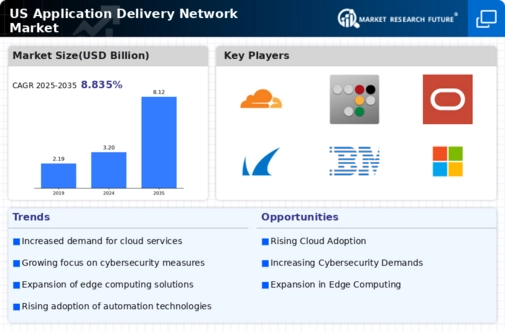Rising Demand for Enhanced User Experience
The application delivery-network market is experiencing a notable surge in demand for enhanced user experience. As organizations increasingly prioritize customer satisfaction, they seek solutions that ensure fast and reliable application performance. This trend is particularly evident in sectors such as e-commerce and online services, where a mere 1-second delay can lead to a 7% reduction in conversions. Consequently, businesses are investing in advanced application delivery solutions to optimize performance and reduce latency. The market is projected to grow at a CAGR of approximately 15% over the next five years, driven by the need for seamless user interactions and the proliferation of mobile applications. This focus on user experience is reshaping the application delivery-network market, compelling providers to innovate and offer solutions that meet evolving customer expectations.
Growing Importance of Multi-Cloud Strategies
The application delivery-network market is witnessing a growing importance of multi-cloud strategies among organizations. As businesses increasingly adopt cloud services from multiple providers, the need for effective application delivery solutions that can seamlessly integrate across diverse environments becomes paramount. Multi-cloud strategies offer flexibility, scalability, and redundancy, which are critical for maintaining application performance and availability. Recent data suggests that over 70% of enterprises are utilizing a multi-cloud approach, highlighting the necessity for application delivery solutions that can operate efficiently across various cloud platforms. This trend is likely to drive significant growth in the application delivery-network market, as organizations seek to optimize their cloud investments and ensure consistent application performance regardless of the underlying infrastructure.
Increased Regulatory Compliance Requirements
the application delivery-network market is increasingly shaped by regulatory compliance requirements. Organizations are facing mounting pressure to adhere to various data protection and privacy regulations, such as the CCPA and GDPR. These regulations necessitate robust security measures and data management practices, which directly impact application delivery strategies. Companies are investing in solutions that not only enhance performance but also ensure compliance with these regulations. The market is expected to see a rise in demand for application delivery solutions that incorporate security features, such as encryption and access controls, to meet compliance standards. This trend indicates a shift towards a more security-focused approach in the application delivery-network market, as organizations strive to protect sensitive data while delivering high-quality applications.
Expansion of Internet of Things (IoT) Applications
The expansion of Internet of Things (IoT) applications is significantly impacting the application delivery-network market. As IoT devices proliferate, the demand for reliable and efficient application delivery solutions that can handle vast amounts of data and ensure low latency is increasing. Industries such as healthcare, manufacturing, and smart cities are leveraging IoT technologies to enhance operational efficiency and improve service delivery. Recent estimates indicate that the number of connected IoT devices is expected to reach 30 billion by 2030, creating a substantial need for application delivery solutions that can support this growth. This trend suggests that the application delivery-network market will continue to evolve, adapting to the unique challenges and requirements posed by the expanding IoT ecosystem.
Integration of Artificial Intelligence and Automation
The integration of artificial intelligence (AI) and automation technologies is transforming the application delivery-network market. Organizations are increasingly leveraging AI to enhance application performance, security, and management. AI-driven analytics can provide real-time insights into application behavior, enabling proactive issue resolution and optimization. Furthermore, automation streamlines deployment processes, reducing operational costs and time. According to recent studies, companies that implement AI in their application delivery strategies report a 30% improvement in operational efficiency. This trend indicates a shift towards more intelligent and automated application delivery solutions, which are essential for maintaining competitive advantage in a rapidly evolving digital landscape. As AI continues to advance, its impact on the application delivery-network market is expected to grow, driving further innovation and efficiency.

















Leave a Comment